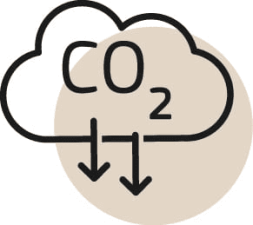The term 'heavy-duty vehicles' (HDVs) refers to:
- Lorries (with a technically permissible maximum laden mass over 3,5 tonnes)
- Buses
- Coaches
HDVs are responsible for more than a quarter of greenhouse gas (GHG) emissions from road transport in the EU, and for over 6% of total EU GHG emissions. In the context of the European Green Deal, the EU has adopted emission standards for HDVs, which will become increasingly strict over time. By lowering demand for fossil fuels, as well as strengthening the development and adoption of zero-emission technologies, these standards support the EU's transition to a clean and sustainable transport system.
CO₂ emission standards for heavy-duty vehicles
According to the Regulation on CO2 emission standards for HDVs, manufacturers will have to comply with targets for fleet-wide average CO2 emissions starting from 2025. These targets will apply to new HDVs registered in the reporting period of a given year, namely from 1 July of that year to 30 June of the following year.
The first-ever EU-wide CO2 emission standards for HDVs were established by Regulation (EU) 2019/1242, which set a 15% reduction target by 2025. Adopted in 2019, these standards are applicable to heavy lorries over 16 tonnes with standard axle configurations, which account for approximately 70% of the CO2 emissions produced by all HDVs.
As part of the 'Fit for 55' legislative package, the emission standards for HDVs set by Regulation (EU) 2019/1242 were revised. The amendments to the Regulation entered into force on 26 June 2024.
The amended Regulation has a wider scope, covering nearly all emissions from HDVs as it applies not only to heavy lorries but also to medium lorries, city buses, coaches, and trailers. As illustrated below, the revised targets are also more ambitious, aiming for increasing CO2 emission reductions in the coming decades:
- 45% by 2030
- 65% by 2035
- 90% by 2040

The revised targets require a percentage reduction of emissions across all vehicles manufactured by a company during a certain reporting period, compared to the EU average of vehicles registered in a specific reference period. The reporting periods of the following years are applicable as reference periods:
- 2019 for vehicles regulated under previous standards;
- 2021 for newly regulated lorries above 7,5 tonnes, as well as lorries with special axle configurations above 16 tonnes;
- 2025 for coaches, trailers, and medium lorries between 5 and 7,5 tonnes.
To reduce transport emissions in urban areas, the amended Regulation mandates that 90% of new city buses must be zero-emission by 2030 and, as of 2035, all new city buses will have to meet the same requirements. Moreover, starting in 2030, CO2 emissions must be reduced by 10% for new semi-trailers and by 7,5% for new trailers other than semi-trailers.
Main benefits of the new standards
The amended Regulation on HDVs will contribute to:
|
| Decreasing CO2 emissions per km from new HDVs by 90% from 2040, as compared to the applicable reference period, with intermediate targets for 2030 and 2035 (45% and 65% decrease, respectively) |
|
| Reaching the EU's 2050 climate neutrality target and boosting zero-emission mobility in Europe |
|
| Improving air quality and health of Europeans by cutting air pollutant levels, especially in towns and cities |
|
| Reducing the fuel expenditure and total cost of ownership for transport operators and all users |
|
| Lowering the EU’s energy dependency on imported fossil fuels, as well as enhancing energy savings and efficiency in the transport sector |
|
| Providing a clear signal to the European industry to pursue a zero-emission pathway by investing in innovative technologies |
|
| Increasing the share of zero and low-emission vehicles in the market, and accelerating the roll-out of recharging and re-fuelling infrastructure |
|
| Reinforcing the technological and innovation leadership of the European industry, in addition to creating new jobs |
Incentive mechanism for zero- and low-emission vehicles (ZLEV)
The amended Regulation includes an incentive mechanism for:
- Zero-emission vehicles (ZEV), i.e. heavy-duty motor vehicles without an internal combustion engine, or with an internal combustion engine emitting less than 3g CO2 per tonne-km or 1g CO2 per person-km.
- Low-emission vehicles (LEV), i.e. heavy-duty vehicles with CO2 emissions less than half of the reference value in their sub-group.
A super-credits system was launched in 2019 to encourage the uptake of ZLEV and reward early action from manufacturers. Valid until the end of 2024, this system can be used to comply with the revised targets in 2025.
Between 2025 and 2029, the super-credits system will be replaced by a benchmark-based crediting system. The benchmark will be set at 2%.
Cost-effective achievement of targets
The amended Regulation includes several measures to support the cost-effective implementation of its provisions:
- Multi-annual emission credits and debts to balance overachievement of targets in one year with underachievement in another year, accounting for long production cycles. While maintaining the environmental integrity of the revised targets, this measure also rewards early action.
- Manufacturers are granted full flexibility to balance emissions between different sub-groups within their portfolio. This includes lorries and trailers (category N and O), as well as buses and coaches (category M vehicles).
- Vocational vehicles, such as garbage lorries and construction vehicles, will be subject to targets from 2035 onwards. However, manufacturers will be allowed to start using zero-emission vocational vehicles for their compliance assessment starting in 2030.
Governance
To ensure the effectiveness and enforcement of the revised targets, the Commission will:
- Assess the robustness and representativeness of reference CO2 emissions as a basis to calculate EU fleet-wide emission targets.
- Collect, publish, and monitor real-world fuel consumption data reported by manufacturers, based on mandatory standardised fuel consumption meters (OBFCM)
- Introduce in-service verification tests and mandate the reporting of deviations, as well as establishing a correction mechanism.
- Apply financial penalties in case of non-compliance with CO2 targets. The penalty level is set at 4,250 euro per gCO2/tkm, starting from 2025.
Determination and reporting of CO₂ emissions from heavy-duty vehicles
The following measures will further enable the implementation of the revised standards:
- Manufacturers determine CO2 emissions and fuel consumption of both new heavy-duty motor vehicles and new trailers, in accordance with Certification Regulations (EU) 2017/2400 and 2022/1362. CO2 emissions and fuel consumption are simulated using the VECTO tool (please find more information below).
- Member States provide information to the Commission on HDVs registered for the first time in the EU during a certain reporting period.
- Manufacturers report data to the Commission on CO2 emissions and fuel consumption for each new vehicle produced for the EU market, as determined by the Certification Regulations. The European Environment Agency then makes this data - along with other relevant technical information, such as aerodynamic drag - publicly available on behalf of the Commission.
The 2024 revision of Regulation (EU) 2019/1242 integrated monitoring and reporting requirements for Member States and manufacturers, repealing Regulation (EU) 2018/956.
Vehicle Energy Consumption calculation TOol (VECTO)
VECTO is a simulation software that cost-effectively and reliably determines CO2 emissions and fuel consumption of HDVs for specific loads, fuels, and mission profiles (e.g. long haul, regional delivery, urban delivery, etc.), based on data from relevant vehicle components. The tool has been developed by the Commission in close cooperation with stakeholders.
CO2 emissions and fuel consumption data determined using VECTO, together with other related parameters, must be monitored and reported to the Commission by manufacturers. The same information must also be made publicly available.
- 06/06/2024 Regulation (EU) 2024/1610 amending Regulation (EU) 2019/1242 on strengthening CO2 emission standards for heavy-duty vehicles
- 14/02/2023 COM/2023/88 Commission proposal
- 14/02/2023 - SWD/2023/88 Impact assessment and SWD/2023/89 executive summary
- 25/07/2019 Regulation (EU) 2019/1242
- 03/07/2018 - COM/2018/284 Commission proposal
- 17/05/2018 - SWD/2018/185 Impact assessment and SWD/2018/186 executive summary
- CO2 Emissions from Heavy-Duty Vehicles (European Environment Agency)
- 05/08/2022 - Regulation 2022/1362 – Energy efficiency determination of heavy-duty trailers
- 28/06/2018 - Regulation 2018/956 repealed by Article 3 of Regulation 2024/1610 of 14 May 2024 with effect from 1 July 2024; see also Article 4 of that Regulation for transitional provisions
- Monitoring and reporting of CO2 emissions from and fuel consumption of new heavy-duty vehicles
- 31/05/2017 - COM/2017/0279 - Proposal on the monitoring and reporting of CO2 emissions from and fuel consumption of new heavy-duty vehicles
- 13/03/2019 - Commission Delegated Regulation (EU) 2018/956 - amending Annex I to Regulation (EU) 2018/956 as regards the data on new heavy-duty vehicles to be monitored and reported by Member States and by manufacturers
- 12/12/2017 - Regulation 2017/2400 - Determination of the CO2 emissions and fuel consumption of heavy-duty vehicles
- 03/2016 - Monitoring heavy-duty vehicles’ CO2 emissions and their costs: An assessment
- Guidance documents and reporting formats
In-service verification
- 08/02/2024 Commission Delegated Regulation 2024/1127 (EU) – guiding principles and criteria
- Draft Text Implementing Regulation (EU) – procedures
Real world
Expert group
- 21/05/2014 - COM (2014) 285 - Communication: Strategy for reducing Heavy-Duty Vehicles' fuel consumption and CO2 emissions
- 21/05/2014 - SWD (2014) 160 - Impact Assessment accompanying the document Strategy for Reducing Heavy-Duty Vehicles Fuel Consumption and CO2 Emissions
- SWD (2014) 159 - Executive summary
- 21/05/2014 - IP/2014/576 - Climate action: Commission sets out strategy to curb CO2 emissions from trucks, buses and coaches
- 21/05/2014 - MEMO/2014/366 - Questions and Answers on the Commission strategy for reducing Heavy-Duty Vehicles' (HDVs) fuel consumption and CO2 emissions
- 26/07/2023 - Final report - Support for aerodynamic modelling of heavy-duty trailers
- 26/07/2023 - Validation report of the computational fluid dynamics simulation method according to Annex V of Regulation (EU) 2022/1362
- 27/09/2022 - Final report: Bodies and trailers - Support Preparation of Legislation on Trailers Certification
- 29/11/2019 - Final report: Further Development of VECTO
- 21/11/2019 - Final report: Bodies and trailers – development of CO2 emissions determination procedure
- 12/2017 - LOT 4 report: "VECTO tool development: Completion of methodology to simulate Heavy Duty Vehicles' fuel consumption and CO2 emissions. Upgrades to the existing version of VECTO and completion of certification methodology to be incorporated into a Commission legislative proposal"
- 12/2017 - Final report: "Feasibility assessment regarding the development of VECTO for hybrid heavy-duty vehicles"
- 27/03/2015 - Light weighting as a means of improving Heavy Duty Vehicles’ energy efficiency and overall CO2 emissions
- 26/01/2015 - Final report: Cost-benefit analysis of options for certification, validation, monitoring and reporting of heavy-duty vehicle fuel consumption and CO2 emissions
- 08/01/2015 - Data gathering and analysis to improve understanding of the fleet, market and CO2 emissions of N2 and M2 category of vehicles
- 08/09/2014 - Cost-benefit analysis of options for certification, validation, monitoring and reporting of heavy-duty vehicle fuel consumption and CO2 emissions (Interim report)
- 15/05/2014 - Development and validation of a methodology for monitoring and certification of greenhouse gas emissions from heavy duty vehicles through vehicle simulation
- 03/02/2014 - Development of a CO2 certification and monitoring methodology for HDV - Proof of concept report
- 29/07/2013 - Tyre Pressure Monitoring Systems (TPMS) as a means to reduce Light- Commercial and Heavy-Duty Vehicles fuel consumption and CO2 emissions
- 18/09/2012 - Final report on HDV CO2 emission abatement cost curves
- 09/01/2012 - Reduction and Testing of Greenhouse Gas Emissions from Heavy-Duty Vehicles - Lot 2: Development and testing of a certification procedure for CO2 emissions and fuel consumption of HDV
- 23/12/2011 - European Union Greenhouse Gas Reduction Potential for Heavy-Duty Vehicles
- 22/02/2011 - Reduction and Testing of Greenhouse Gas Emissions from Heavy-Duty Vehicles – Lot 1: Strategy
- 03/2008 - Reducing Greenhouse Gas Emissions from Heavy-Duty Vehicles








